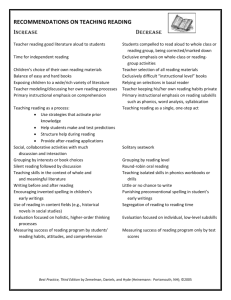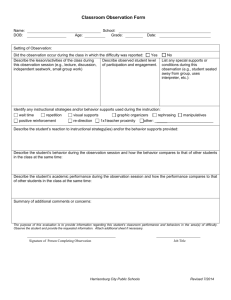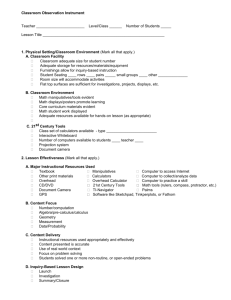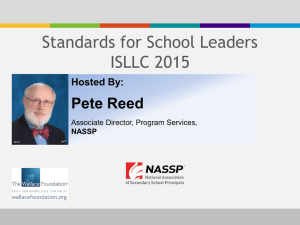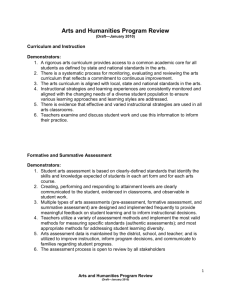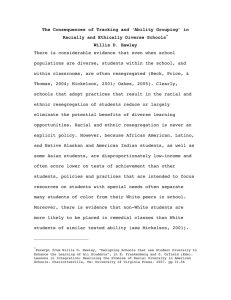Making the most of learning time
advertisement
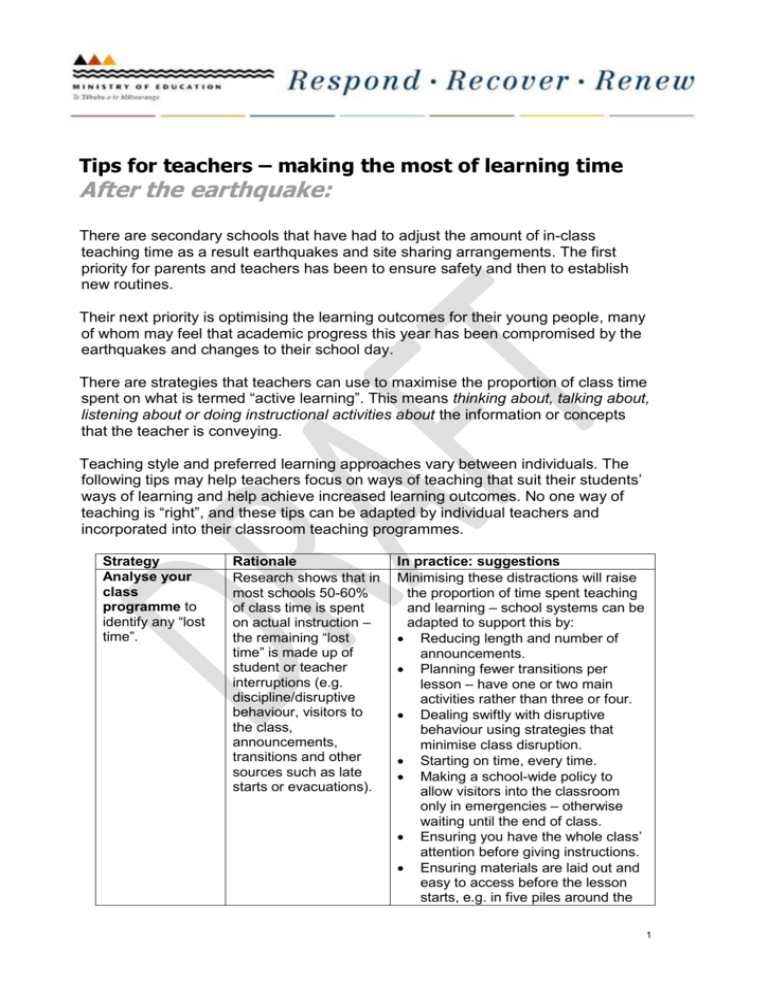
Tips for teachers – making the most of learning time After the earthquake: There are secondary schools that have had to adjust the amount of in-class teaching time as a result earthquakes and site sharing arrangements. The first priority for parents and teachers has been to ensure safety and then to establish new routines. Their next priority is optimising the learning outcomes for their young people, many of whom may feel that academic progress this year has been compromised by the earthquakes and changes to their school day. There are strategies that teachers can use to maximise the proportion of class time spent on what is termed “active learning”. This means thinking about, talking about, listening about or doing instructional activities about the information or concepts that the teacher is conveying. Teaching style and preferred learning approaches vary between individuals. The following tips may help teachers focus on ways of teaching that suit their students’ ways of learning and help achieve increased learning outcomes. No one way of teaching is “right”, and these tips can be adapted by individual teachers and incorporated into their classroom teaching programmes. Strategy Analyse your class programme to identify any “lost time”. Rationale Research shows that in most schools 50-60% of class time is spent on actual instruction – the remaining “lost time” is made up of student or teacher interruptions (e.g. discipline/disruptive behaviour, visitors to the class, announcements, transitions and other sources such as late starts or evacuations). In practice: suggestions Minimising these distractions will raise the proportion of time spent teaching and learning – school systems can be adapted to support this by: Reducing length and number of announcements. Planning fewer transitions per lesson – have one or two main activities rather than three or four. Dealing swiftly with disruptive behaviour using strategies that minimise class disruption. Starting on time, every time. Making a school-wide policy to allow visitors into the classroom only in emergencies – otherwise waiting until the end of class. Ensuring you have the whole class’ attention before giving instructions. Ensuring materials are laid out and easy to access before the lesson starts, e.g. in five piles around the 1 room rather than in one corner. Classrooms with a strong academic focus share the following characteristics: Systematic, teacher-structured activities. Lessons and content related to attaining specific goals*. Rapid pacing of lessons. Ready availability of teaching materials. High levels of student participation and responding. Student accountability for homework. Frequent monitoring of students’ performance through weekly and monthly tests. Instructions should be written and placed where they can be seen and referred to by students as needed. Teachers can ask students to paraphrase the directions and selfidentify problems that might occur in following directions. It may help to distribute outlines, definitions or study guides to help students organise their thoughts and focus their attention (see below). Check students’ background experience with the current topic. They may be familiar with concepts, so can begin at a higher level. If students’ interests are unknown, find out and plan lessons to incorporate these. Test frequently enough that the approximate level of each student is known. Group students according to ability and provide different levels of difficulty so that they can answer approximately four out of five questions correctly. Have a strong academic focus. Academic focus is reflected in the amount of time devoted to academic versus nonacademic activities and in the type of instructional interaction that prevails in the classroom. Clear instructions for learning activities. A significant amount of lost time results when students do not understand how they are to proceed with assigned tasks. Once trouble spots are identified, workable solutions can be generated. Match response requirements to students’ interest, ability level and background knowledge. Active learning tasks can be planned to maximise productive learning. More productive active learning occurs when the set tasks are wellmatched to the students’ interest, ability level and background knowledge (Research shows that young people gain most from learning time when they experience about 80% accuracy in responding). This allows teachers to maximise active learning for all students. Whole-class instruction may not provide individual students with enough opportunities to Use flexible grouping practices. Membership in groups can change on the basis of specific needs of students and the nature of the learning activity. Heterogenous group arrangements foster high levels of engagement. Students co-ordinate their individual 2 respond, or material at the right difficulty level. Seatwork can lead to high levels of success but may minimise engagement. The use of flexible grouping practices can circumvent some of the problems inherent in individual or wholeclass teaching. Consider ways to modify current activities to be more interactive, encouraging all students to respond in some way during every learning activity. Interactive activities are more productive than non-interactive activities such as silent reading or independent seatwork. skills for a common goal. This is appropriate for exploratory-type tasks such as problem-solving. Homogeneous grouping allows students to work on material according to their pace and current level. This is more appropriate for prescriptive tasks such as solving set problems. Consider using peer tutoring: students take turns serving as tutors (providing feedback about responses) or tutees (responding to academic prompts). This keeps all students consistently engaged in the task, providing instructional content is chosen carefully. Have small groups read together by taking turns to read aloud rather than silent reading at desks. Solve a set of problems together rather than alone. Get students to present results of learning activities to the class, and then take questions from the class. Direct questions to students randomly or in ordered turns so that everyone is asked. Plan each class session with the above principles in mind. However, all of these strategies take time and effort to implement – it may be possible to change only one or two things at a time. But remember, small changes in practice can lead to large improvements. *The following page gives a template for a student handout that can be used for every lesson. It effectively orients the student to the lesson’s learning objectives and main ideas, as well as giving them summary notes to review later. Gettinger, M. & Seibert, J. K. (2002). Best Practices in Increasing Academic Learning Time. In A. Thomas & J. Grimes (Eds.), Best Practices in School Psychology. Bethesda, MD: National Association of School Psychologists. 3 Lesson Format Unit of work or subject. This is for filing purposes. Reference: Date: Topic: Commentary: Important Terms, Concepts and This is where the student records – The title of the lesson. This may be part of a series of lessons on the one topic Lesson is dated. Header: Title: Focusing Question: Notes: A question that gives students focus and purpose for the lesson Thoughts: This is considered the working space. Notes and schemas (mind maps, diagrams, pictures, graphs) are recorded here. Key concepts, Vocabulary and Lesson Summary. This may be recorded as visual representation, (schema) or in words. The key skill(s) identified in here. Key Skill: Review: Reflection/Summary Homestudy requirements identified and recorded here. 4 Reference: Date: Topic: Commentary: Header: Title: Focusing Question: Notes: Important Terms, Concepts and Thoughts: Key Skill: Review: Reflection/Summar 5 6
